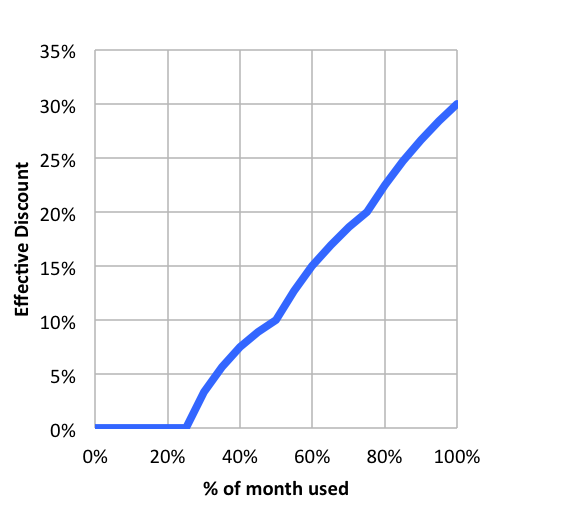How FinOps Procurement and Optimization Strategies Can Create Value for Your Organization
This is the final in a series of three articles on the importance and characteristics of FinOps for managing cloud spend, its business justifications and what it all means for your organization. Click to read the first or second posts.
In our past two posts on FinOps, we’ve outlined the significant cloud-related cost issues faced by organizations that don’t have full visibility into their cloud operations. A recent survey from Flexera indicates that 73 percent of finance and IT leaders say reducing cloud costs is their top priority.
We’ve also explained, at a relatively high level, how FinOps (also known as cloud cost optimization) can help, especially in a cloud environment rife with decentralized, ad-hoc cloud purchases and uncoordinated consumption strategies across the enterprise. Getting full visibility into cloud consumption and costs with a commitment to FinOps best practices can help you assess where efficiencies can be found.
Let’s discuss how organizations maximize the value of their cloud spend using a FinOps approach to procurement and optimization.
Procurement
One of the most important keys to cost-optimized cloud services is having the right procurement strategy in place, coordinated and executed with a cross-functional Cloud Cost Center of Excellence. That’s because cloud services require accurate resource planning, forecasting and budgeting.
Cloud consumption and cost forecasting feed your procurement strategy. This requires accurate predictions of monthly cloud usage, an intimate knowledge of future scaling requirements, and an ability to reserve the correct amount of resources in advance. Our guide can help you to see how Cloud computing fundamentally changes IT financial management.
Procurement teams must also familiarize themselves with a seemingly infinite variety of cloud subscription services, options, terminologies and payment models. Since each cloud vendor calculates fees slightly differently and contract terms and discounts can vary, Pythian recommends continuous nontraditional planning, design, tracking and reporting across multiple teams in IT, finance and business stakeholder groups.
Other ways organizations can optimize their cloud procurement include:
- Capacity reservations: For clients who want to have absolute certainty that resources will be available to them, they can reserve compute capacity in a specific region. This capability exists across all cloud vendors in different forms, but can generate significant savings. According to Microsoft, users can reduce costs up to 72 percent compared to pay-as-you-go pricing for select Azure services. AWS and Google Cloud customers can earn similar discounts for Reserved Instances.
- Committed use discounts: Cloud vendors and services offer committed use discounts, where companies reserve a certain amount of use up front (for a specific amount of time) in exchange for deep discounts. For obvious reasons, this option tends to work best for organizations with predictable workloads. Google Cloud’s committed use discounts for its Compute Engine include price reductions of as much as 70 percent—but you have to commit to those resources for one to three years.
- Spot instances: We mentioned spot instances such as Azure Spot Virtual Machines, Amazon EC2 Spot and Google Cloud Preemptible Virtual Machines (VMs) in our previous FinOps post. They’re short-lived yet powerful instances that run at a reduced price – AWS offers price reductions on spot resources of up to 90 percent—for a short time. Google says its Preemptible VMs can save organizations as much as 80 percent, but they are best suited to fault-tolerant workloads that can handle instance preemptions and batch jobs.
- Slot reservations (via Google BigQuery): Currently offered by Google’s BigQuery data warehouse, slot reservations allow customers to commit to a certain number of BigQuery slots for a flat rate. A BigQuery slot is a virtual CPU used by BigQuery to execute SQL queries. As opposed to BigQuery’s on-demand pricing, flat-rate pricing offers better predictability and flexibility. But as is the case with committed use discounts, you’ve got to have a good idea of your future consumption needs to make slot reservations work.
- Sustained use discounts: Sustained use discounts (or volume discounts) are automatic discounts offered by vendors based on the volume of cloud resources consumed during a particular billing cycle. Google offers sustained use discounts of up to 30 percent based on volume usage, as illustrated in the chart below:

Image courtesy of Google Cloud
Optimization
A well-executed FinOps strategy can have a profound impact on your day-to-day cloud costs. Organizations that run in the cloud but use a traditional IT financial management model typically can’t take advantage of these optimizations due to a lack of visibility around the cloud resources consumed by specific groups, individuals or instances.
It’s important to note, however, that FinOps-driven cloud optimizations aren’t about skimping on quality; rather, they enable business owners to move faster with fiscal transparency. FinOps optimizations demand accountability from line-of-business owners to improve cost, no doubt, but also to boost performance and quality standards across the enterprise. “Optimization recommendations help ensure that cloud resources comprising a workload are provisioned to minimize cost while still providing the required performance and functionality,” says the FinOps Foundation, adding that manually identifying idle or badly provisioned resources through traditional approaches can be a huge challenge.
There are several concrete steps organizations can take to improve cloud optimization under a FinOps approach, including:
- 1. Right-sizing of cloud instances: Rightsizing or resizing cloud instances is an ongoing process that helps organizations use cloud resources more efficiently by eliminating unnecessary or oversized instances (which usually result in wasted money and unused capacity). AWS says rightsizing is “the process of matching instance types and sizes to your workload performance and capacity requirements at the lowest possible cost,” along with “looking at deployed instances and identifying opportunities to eliminate or downsize without compromising capacity or other requirements.”
While right sizing is rarely an immediate concern for organizations just starting out on cloud, it probably should be in order to avoid accruing a large amount of unused capacity.
- 2. Killing Zombies: “Zombie” instances are similar to the above in that they are cloud assets that get spun up and run in the background – often consuming a significant amount of provisioned resources – but aren’t brought down when no longer needed. The most common types of zombies include unattached volumes, obsolete snapshots, unused elastic load balancers and unused elastic IP addresses. Eliminating these unused resources can drive considerable improvements in cloud operations and save a significant amount of money.
- 3. Real-time anomaly detection: Detection of anomalies in real time using a traditional (read: manual) approach can be a little like searching for the proverbial needle in a haystack while blindfolded. The automated cost management inherent in a FinOps approach helps detect (or even predict) abnormal patterns in unbounded data streams. Google’s BigQuery, for example, uses machine learning to analyze patterns in your data to detect outliers that could mean trouble.
Other types of optimizations include mapping the right type of resources to your intended purpose to ensure minimum overhead costs, determining the right number or amount of resources within various groups, moving to managed services or auto-scaling services, and identifying services that are potentially overpriced for the value they bring.
As a market leader in data, analytics and cloud, Pythian’s FinOps practice helps enterprises make sense of their cloud consumption to get costs under control. Our FinOps services provide the visibility, tools and guidance necessary to help you control, manage and optimize cloud costs with sophisticated reporting and analytics capabilities that can be shared across your organization.
Get in touch with Pythian today to learn how we can save you an average of 25 percent in your monthly cloud spend.
Share this
You May Also Like
These Related Stories

How to optimize your Google Cloud consumption with self-managed tools from Pythian

No Comments Yet
Let us know what you think